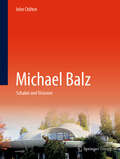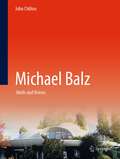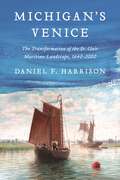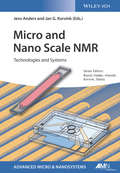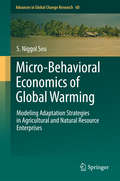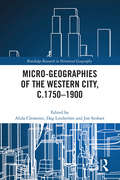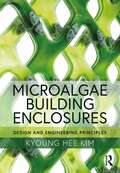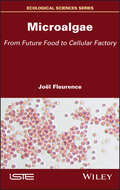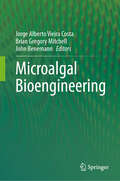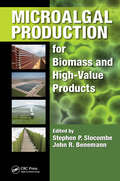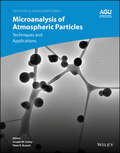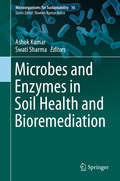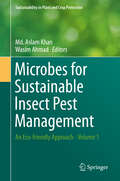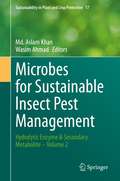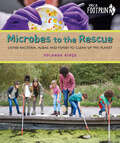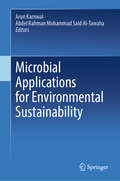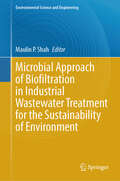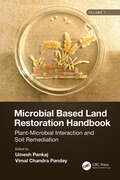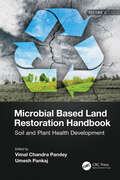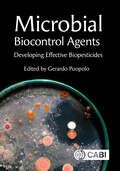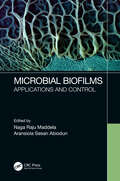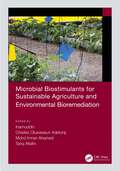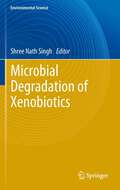- Table View
- List View
Miami in the Anthropocene: Rising Seas and Urban Resilience
by Stephanie WakefieldReimagining adaptation amidst climate change–driven mutations of urban space and life Between its susceptibility to flooding and an ever-expanding real estate market powered by global surges of people and capital, Miami is an epicenter of the urban Anthropocene and a living laboratory for adaptation to sea level rise. Miami in the Anthropocene explores the social, environmental, and technical transformations involved in climate adaptation infrastructure and imaginaries in a global city seen as climate change ground zero. Using Miami as a compelling microcosm for understanding the complex interplay between urbanization and environmental upheaval in the twenty-first century, Stephanie Wakefield shows how &“aqua-urban futures&” are being imagined for the city, from governmental scenario exercises for severe weather events to proposals to transform the city&’s metropolitan area into an archipelago of islands connected by bridges. She examines the shifts reweaving the fabric of urban life and presents designs that imagine dramatic new ways of living with water. Grounded in the dynamic landscape of Miami but reaching far beyond its shores, Miami in the Anthropocene delves into the broader debates shaping urban thought and practice in the Anthropocene. Focusing on postresilience urban designs, Wakefield illuminates the path toward a future where cities embrace opportunities for evolution rather than merely for survival.
Michael Balz: Schalen und Visionen
by John ChiltonDieses Buch gibt einen Überblick über das Werk des Architekten Michael Balz, dem Pionier der Betonschalenarchitektur. Es behandelt seine realisierten und nicht realisierten Projekte, von denen viele in Zusammenarbeit mit dem renommierten Schweizer Ingenieur Heinz Isler entworfen wurden.Michael Balz. Schalen und Visionen ist reichlich mit Originalzeichnungen und Fotos illustriert: Schalen und Visionen trägt dem zunehmenden Interesse am Entwurf und der Konstruktion von Stahlbeton-Freiformschalen Rechnung, das mit dem Aufkommen von 3D-Modellierungs- und Formfindungssoftware einhergeht. Das Buch beschreibt architektonische Entwürfe und praktische Konstruktionsfragen, um zeitgenössische Schalendesigner zu motivieren.Balz' Erfahrung im Umgang mit Schwierigkeiten wie der Unvereinbarkeit mit nicht-strukturellen Merkmalen und dem Einbau von Fenstern in Schalen sowie der Bewertung der langfristigen Leistungsfähigkeit von Gebäuden ermöglicht es den Lesern, leichterzu lernen, wie sie mit solchen Problemen bei ihrer eigenen Arbeit umgehen können.Das Buch stellt Michael Balz vor, seine frühe Arbeit mit anderen Architekten, einschließlich seiner Arbeit an pneumatischen Formen mit Frei Otto, und seine Entwicklung zu einem Vertreter der organischen Architektur. Anschließend werden realisierte Projekte besprochen, darunter das Theater unter den Kuppeln (1976), der Ballettsaal (1979) und das Haus Balz (1981). Wettbewerbe, an denen Balz teilgenommen hat, und nicht realisierte Rohbauprojekte finden ebenfalls Beachtung, ebenso wie seine Arbeiten im städtischen Maßstab, wobei die konzeptionellen Entwürfe für Megastädte im Mittelpunkt stehen. Seine visionären Megastrukturen ermutigen Architekten, angesichts der zunehmenden Urbanisierung innovative Lösungen für den Stadtraum zu finden. Michael Balz: Schalen und Visionen wird für Studenten und Fachleute aus den Bereichen Architektur, Bauingenieurwesen, Bauwesen und Stadtplanung vonInteresse sein. Die Überlegungen zu den kulturellen und kontextuellen Aspekten von Balz' Werk werden dem Architekturhistoriker helfen, seine langfristige Bedeutung zu schätzen.
Michael Balz: Shells and Visions
by John ChiltonThis book presents a review of the work of the architect Michael Balz, pioneer of concrete-shell architecture. It discusses his projects, both realized and unbuilt, many being designed in collaboration with the renowned Swiss engineer Heinz Isler.Profusely illustrated with original drawings and photographs, Michael Balz: Shells and Visions caters to the increasing interest in the design and construction of free-form reinforced concrete shells consequent on the advent of 3D modelling and form-finding software. The book describes architectural designs and practical construction issues to motivate contemporary shell designers.Balz’s experience of dealing with such difficulties as incompatibility with non-structural features and the insertion of windows into shells, and the assessment of buildings’ long-term performance allow readers to learn more easily how to cope with such issues in their own work.The book introduces Michael Balz, his early work with other architects, including his work on pneumatic forms with Frei Otto, and his evolution into an exponent of organic architecture. It then discusses completed projects, including the outdoor Theater unter den Kuppeln (1976), Ballettsaal (1979) and Balz House (1981). Competitions Balz entered and unrealized shell projects also receive attention, as does his work on the urban scale, highlighting conceptual designs of mega-cities. His visionary megastructures encourage the exploration of innovative solutions for city spaces by architects faced with today’s increased urbanization. Michael Balz: Shells and Visions will be of interest to students and professionals in the fields of architecture, structural engineering, building and urban design. It’s reflections on the cultural and contextual aspects of Balz’s work will help the architectural historian to appreciate its long-term significance.
Michigan’s Venice: The Transformation of the St. Clair Maritime Landscape, 1640–2000
by Daniel F. HarrisonFew maritime landscapes in the Great Lakes remain so deeply and clearly inscribed by successive cultures as the St. Clair system—a river, delta, and lake found between Lake Huron and the Detroit River. The St. Clair River and its environs are an age-old transportation nexus of land and water routes, a strategic point of access to maritime resources, and, in many ways, a natural impediment to the navigation of the Great Lakes. From Indigenous peoples and European colonizers to the modern nations of Canada and the United States, this work traces the region’s transformation through culturally driven practices and artifacts of shipbuilding, navigation, place naming, and mapmaking. In this novel approach to maritime landscape archaeology, author Daniel F. Harrison unifies historiography, linguistics, ethnohistory, geography, and literature through the analysis of primary sources, material culture, and ecological and geographic data in a technique he calls "evidence-based storytelling." Viewed over time, the region forms a microcosm of the interplay of environment, culture, and technology that characterized the gradual shift from nature to an industrial society and a built environment optimized for global waterborne transport.
Micro and Nano Scale NMR: Technologies and Systems (Advanced Micro and Nanosystems)
by Gary K. Fedder Osamu Tabata Christofer Hierold Jan G. Korvink Oliver Brand Jens AndersThis must-have book is the first self-contained summary of recent developments in the field of microscale nuclear magnetic resonance hardware, covering the entire technology from miniaturized detectors, the signal processing chain, and detection sequences. Chapters cover the latest advances in interventional NMR and implantable NMR sensors, as well as in using CMOS technology to manufacture miniaturized, highly scalable NMR detectors for NMR microscopy and high-throughput arrays of NMR spectroscopy detectors.
Micro-Behavioral Economics of Global Warming
by S. Niggol SeoThis book presents a foundation for studying the micro-behavioral economics of global warming. The author develops an empirical model, named the Geographically-scaled Micro econometric model of Adapting Portfolios (G-MAP) in response to climatic changes and risks. The G-MAP model is applied to observed decisions of agricultural and natural resource enterprises in Sub-Saharan Africa and South America. The author describes the five applications of the model: the G-MAP animal species, the G-MAP agricultural systems, the G-MAP natural resource enterprises, the G-MAP climate risk, and the G-MAP public adaptations. The micro-behavioral economics of global warming and the G-MAP models are evaluated against the three alternative modeling traditions: The first is the Agro-Economic Models (AEM) based on crop simulations of selected crops under elevated CO2 conditions; The second is a family of econometric studies of grain yield changes caused by yearly weather fluctuations; The third is the Agro-Ecological Zone (AEZ) method hinged crucially on the AEZ classifications of ecosystems. The author offers a refreshing look at the traditional economics of global warming, unraveling a broad array of adaptation strategies adopted by managers of agricultural and natural resource enterprises in Sub-Saharan Africa and South America. The book demonstrates that the micro-behavioral economics dynamically integrates multiple disciplines in a cohesive way - including economics, psychology, climate science, ecosystem studies, agronomy and animal science - into the decision-making framework of an individual agent. The G-MAP models provide a guide map of adaptation strategies for the humanity's enduring journey of battling global climatic changes in this century and beyond.
Micro-Pollutant Regulation in the River Rhine: Cooperation in a Common-Pool Resource Problem Setting
by Laura Mae HerzogThis book investigates how actors organize in order to solve a water quality problem. Research on the use of environmental resources has mainly focused on the circumstances needed for users to self-organize or to maintain an already sustainable way of resource use. Few studies have investigated the reasons why actors start to cooperate when they are faced with an environmental problem. Actor networks in three regions of the Rhine catchment area are scrutinized regarding a) actors’ cooperation pattern when managing an environmental problem; and b) the factors that trigger actors in a common-pool resource situation to initiate cooperation. Water quality policy is analysed in two European countries – Germany and Luxembourg – and one non-European country - Switzerland –, providing an overview of the distinctive measures applied in these regions aiming to tackle the water quality problem of micro-pollutants in river surface water. Applying the social-ecological system framework (SESF) devised by E. Ostrom and her colleagues and Social Network Analysis (SNA), the current book combines qualitative and quantitative methods to answer the question of why actors cooperate in the management process of an environmental problem like water pollution.
Micro-geographies of the Western City, c.1750–1900 (Routledge Research in Historical Geography)
by Alida Clemente; Dag Lindström; Jon StobartThis book examines the overlapping spaces in modern Western cities to explore the small-scale processes that shaped these cities between c.1750 and 1900. It highlights the ways in which time and space matter, framing individual actions and practices and their impact on larger urban processes. It draws on the original and detailed studies of cities in Europe and North America through a micro-geographical approach to unravel urban practices, experiences and representations at three different scales: the dwelling, the street and the neighbourhood. Part I explores the changing spatiality of housing, examining the complex and contingent relationship between public and private, and commercial and domestic, as well as the relationship between representations and lived experiences. Part II delves into the street as a thoroughfare, connecting the city, but also as a site of contestation over the control and character of urban spaces. Part III draws attention to the neighbourhood as a residential grouping and as a series of spaces connecting flows of people integrating the urban space. Drawing on a range of methodologies, from space syntax and axial analysis to detailed descriptions of individual buildings, this book blends spatial theory and ideas of place with micro-history. With its fresh perspectives on the Western city created through the built environment and the everyday actions of city dwellers, the book will interest historical geographers, urban historians and architects involved in planning of cities across Europe and North America.
Microalgae Building Enclosures: Design and Engineering Principles
by Kyoung Hee KimMicroalgae architecture has gained awareness for its biotechnical potential to achieve net-zero energy architecture while also promoting ecological sustainability and occupant well-being. Microalgae Building Enclosures: Design and Engineering Principles aims to provide design, engineering, and biotechnical guidelines for microalgae building enclosures that need to be considered for symbiotic relations among the built environment, humans, and ecosystems. Part I of the book introduces the theoretical background of microalgae as a bioremediator and future energy system and their potential roles toward sustainable and healthy built environments. Part II exemplifies interventions and multiple benefits of microalgae systems in product, architecture, urban, and infrastructure applications across the globe including Africa, Asia, Australia, Europe, South America, and North America. Part III explains the design and engineering criteria, biotechnical design requirements, and various performance metrics for microalgae architecture. Finally, Part IV investigates potential building applications in low-rise buildings, high-rise buildings, and energy-efficient retrofitting. The book also includes international case studies of microalgae building systems within various building types and climates. As one of the first books to comprehensively cover this emerging area of microalgae building enclosures, Microalgae Building Enclosures is an essential source for professionals and students looking to expand architectural discourse on nature integrated building systems to achieve the triple bottom line of sustainability.
Microalgae: From Future Food to Cellular Factory
by Joel FleurenceMicroalgae and cyanobacteria are the first organisms in the oceanic food chain and are essential producers of oxygen and effective carbon dioxide traps. They are traditional sources of food proteins for Aztec, African and Asian populations, and some of them have even acquired the status of superfoods. Microalgae reviews the biological, ecological and biochemical characteristics of microalgae and cyanobacteria. They are true cellular factories, producing substances of interest such as original pigments, proteins and polysaccharides with biological activities. Their use covers many sectors of human activity including aquaculture, livestock breeding, agri-food, and human and veterinary medicine.This book presents their mode of production and the transformation processes that are applied to them, as well as the traditional and future valorization of algae. As they are a source of lipids and fatty acids, microalgae have become the focus of attention for the development of green fuels, such as biofuel.
Microalgal Bioengineering
by Jorge Alberto Vieira Costa Brian Gregory Mitchell John BenemannThis book presents recent advances, challenges, and trends in modern microalgal biotechnology. It covers microalgae genetics, bioreactors, modeling, massive scale and industrial cultivation, and environmental, social, and economic aspects of microalgal biotechnology. The book also explores the emerging knowledge about high-value bioproducts from microalgae, e.g., biofuels, biosurfactants, bioremediation, bioplastics/biopolymers, pharmaceuticals, antioxidants (anti-aging), fatty acids, polysaccharides and proteins, feed and superfoods with microalgae. The chapters will be written by prominent professors and researchers from the six inhabited continents of the world, from academic to industrial sectors.
Microalgal Production for Biomass and High-Value Products
by Stephen P. Slocombe John R. BenemannMicroalgae are a particularly interesting source of products that range from currently marketed human nutritionals and food ingredients, to potential sources of biofuels and animal feeds. Rapid advances in technology and commercial development are taking place worldwide. Importantly, algal cultivation does not compete with agriculture for land, water, and in some cases, fertilizer resources. Microalgal Production for Biomass and High-Value Products covers the field from a variety of perspectives with 14 chapters contributed by recognized academic experts and industrial practitioners. The book presents the latest technologies and innovations in algal biomass production, from cultivation in open ponds and photobioreactors, to strain selection, synthetic biology, pest control, harvesting, and processing. It explores novel algal products and addresses key issues, including markets, supply chains, business strategies, legal issues, current products, and future prospects. This book brings together the latest advances of interest to those already working in the field while providing an introduction to those beginning to learn about the promise of microalgae as a sustainable source of both specialty and commodity products. It gives stimulating overviews from many different perspectives that describe how laboratory and applied research are creating advances in commercial microalgae production. It also addresses the still many open questions and challenges in this field.
Microanalysis of Atmospheric Particles: Techniques and Applications (Geophysical Monograph Series #287)
by Joseph M. Conny Peter R. BuseckMicroanalysis of Atmospheric Particles Techniques and Applications Most of what is visible in the atmosphere—such as pollution, dust, haze, fog, and clouds—is due to micrometer- and nanometer-sized aerosol particles. It is important to understand the source, characteristics, and behavior of these small particles as they play a fundamental role in large-scale atmospheric processes. Microanalysis of Atmospheric Particles: Techniques and Applications presents different microscopic techniques for studying aerosols and explores a range of applications in climate studies and air quality studies. Volume highlights include: Overview of different techniques and applications In-depth descriptions of scanning electron microscopy, transmission electron microscopy, electron energy loss spectroscopy, Raman microspectroscopy, and atomic force microscopy Techniques for studying physical characteristics and chemical composition Methods to examine particle transformation Examples including soot, organic aerosols, ice crystals, and sea spray Applications for global and regional climate change and urban air quality The American Geophysical Union promotes discovery in Earth and space science for the benefit of humanity. Its publications disseminate scientific knowledge and provide resources for researchers, students, and professionals.
Microbes and Enzymes in Soil Health and Bioremediation (Microorganisms for Sustainability #16)
by Ashok Kumar Swati SharmaMicrobial enzymes play a vital role in maintaining soil health and removing pollutants from contaminated land. Soil microflora is closely associated with maintaining soil fertility, and the use of chemical pesticides, fertilizers and other volatile sprays in agriculture threatens the health ofthe microbial population in the soil. Every single particle of healthy soil contains millions of bacteria, which interact with the nutrients available, sustaining the nutrient cycle and making this microflora an essential component of life on earth. How do microbes help in the nutrient cycle? Either by intracellular digestion of macromolecules and converting these into smaller units in their metabolic pathways, or by secreting enzymes into the extracellular environment to facilitate the conversion of complex macromolecules into micro-molecules that can be easily absorbed by other living species. To meet demands for energy and food for the growing global population, it is important to protect agricultural land from contamination and maintain its productivity. Heavy metal ions from contaminated land canenter crops, fish or aquatic organismsvia contaminated water, and theseare then taken up by the human body, where they can accumulate and alter the normal microflora.The microbiological component of the soil is ahighly complex system and is still not fully understood. How do microbes survive in the changing physicochemical environment of soil?. This book helps readers understand the mechanism, various routes of microbialsoil remediation, the interactionsof different genera, and how microbial enzymes support the sustainable restoration of healthy soil.
Microbes for Sustainable Insect Pest Management: An Eco-friendly Approach - Volume 1 (Sustainability in Plant and Crop Protection)
by Md. Aslam Khan Wasim AhmadThis Volume comprises 14 chapters in an attempt to provide the reader with available information on safe and effective use of entomopathogens. Chapters in this book dealing with soil-borne entomopathogens and their phylogeny also provide a review on most updated information of their isolation and molecular identification. Employing fungal pathogens in biological control programmes plays a key role, and conidial thermotolerance and oxidative stress are examined in separate chapters. Entomopathogenic bacteria are able to kill their hosts quickly. An important contribution concerns informations provided upon bacterial cytotoxic factors on insect haemocytes. Nematodes are biological control agents safe to the environment. The information with respect to their direct and indirect effects on non-target organisms is provided. Viruses as highly specific, virulent candidates for use as biological insecticides are safe to non-target species. A separate chapter on the role of granuloviruses in IPM contributes a wealth of information. Biopesticides in combination with synthetic insecticides are reported as effective, economic, and eco-friendly. Understanding their interactions will certainly promote their uses. Finally, emphasis has been given on reviewing synergistic and antagonistic interactions of microbial and chemical pesticides, in other chapters.
Microbes for Sustainable lnsect Pest Management: Hydrolytic Enzyme & Secondary Metabolite – Volume 2 (Sustainability in Plant and Crop Protection #17)
by Md. Aslam Khan Wasim AhmadThe search for new strategies of pest control with safer molecules is currently of great importance and interest. Microbe-mediated biological crop protection is an attractive and promising technology with no concern for a negative impact on the environment and biodiversity. Microbial hydrolytic enzymes such as proteases, chitinases, lipases, etc. are attractive for this purpose. They present toxic properties and act synergistically to control pest attacks. Also, some metabolites, that microorganisms produce for their survival or defense, can be explored and exploited for plant protection. The focus of this Volume is on the potential of microbial hydrolytic enzymes and their metabolites in agroecosystem functioning. Subsequent chapters review topics such as microbial hydrolytic enzymes as powerful management tools, chitinases in IPM of agro-horticultural crops, metabolites as pesticides and the importance of the metabolites of entomopathogenic fungi, metabolites and virulence factors. Other topicas include: microbial-based nanoparticles, recombinant DNA technologies to improve the efficacy of microbial insecticides, the effects of entomopathogens on insect predators and parasitoids, and the management of major vegetable insect pests. This Volume provides detailed accounts on the safe use of microbial products for sustainable management of insect pests. Its aim is to build solid foundations for the students, teachers, and researchers interested in eco-friendly management of important insect crop pests.
Microbes to the Rescue: Using Bacteria, Algae and Fungi to Clean Up the Planet (Orca Footprints)
by Yolanda RidgeMicrobes are tiny but mighty, and they're everywhere! When left alone, microbes such as bacteria, fungi and algae are experts at adapting, surviving and thriving under extreme and constantly changing conditions. These natural problem solvers can help fight the climate crisis by gobbling up pollutants, breaking down plastic, generating clean energy and capturing carbon. By harnessing the power of microbes, we can create eco-friendly packaging, farm-free food, and even make it easier to live in space! Microbes to the Rescue will introduce young readers to life on a microscopic level and explore how bacteria, fungi and algae play a key role in the connection between all life on Earth. Let’s get microscopic and learn about how microbes can create a cleaner and more sustainable future. The epub edition of this title is fully accessible.
Microbial Applications for Environmental Sustainability
by Arun Karnwal Abdel Rahman Mohammad Said Al-TawahaThis book focuses on the various applications of microorganisms for sustainable environment and the reduction of hazardous pollutants released in various forms, including xenobiotics, e-waste, pesticides, insecticides, plastic, heavy metals, paper waste, medical waste, textile dyes, and their impact on environmental and human health. The book involves a series of research reports that explain the application of microbes used to solve real-life issues raised due to changes happening in environment, including pollution, by covering applications, including the use of bacteria, fungi, microalgae and biofilm in the detection and degradation of crude oil, pesticides, dyes, e-waste, heavy metals and other pollutants. It also focuses on integrative strategies in the application of microbial nanomaterials for remediation of pollutant. This material will help environmental scientists and microbiologists to learn about existing environmental problems and suggest novel ways to control or contain their effects by employing various treatment approaches.
Microbial Approach of Biofiltration in Industrial Wastewater Treatment for the Sustainability of Environment (Environmental Science and Engineering)
by Maulin P. ShahThe ever-increasing number of pollutants released into the environment drives the search for new treatment technologies or the modification of existing ones. In this sense, innovation in biofiltration systems seems promising, and therefore, a book on the current developments and innovations on its subject is very appropriate. Biofiltration is a relatively emerging new technology applied to the treatment of wastewater and other toxic substances. Over the past two decades, this technology has become an economically viable process for treating the wide variety of unruly pollutants released into the environment. For example, it is speculated that the US biofiltration market will reach more than $100 million by 2020. This book aims to show how innovation in biofiltration can provide effective solutions to overcome the serious problem of water pollution worldwide. The removal of contaminants will result from the combined effects of biological oxidation, adsorption, and filtration processes. Many physicochemical and operational factors influence the performance, treatment costs, and long-term stability of biofilters for wastewater treatment. This book focuses on identifying factors that affect biofiltration, explains their influence, and provides guidelines on how to control these factors to optimize better control over the control of pollutants present in wastewater treatment plants. The fundamental basis of treatment in biofilters is the action of microorganisms that degrade pollutants, and consequently, the book also discusses in depth the microbial ecology of biofiltration.
Microbial Based Land Restoration Handbook, Volume 1: Plant-Microbial Interaction and Soil Remediation
by Umesh Pankaj Vimal Chandra PandeyPlant-microbe interaction is a powerful and promising link to mitigate the various kinds of stresses like drought, salinity, heavy metals, and pathogenic effects. It is more beneficial for crop improvement and sustainable approaches for reclamation of problematic soils. Taking a multidisciplinary approach, this book explores the recent uses of plant-microbe interactions in ecological and agricultural revitalization beyond normal agriculture practices and offers practical and applied solutions for the restoration of degraded land to fulfill human needs with food, fodder, fuel, and fiber. It provides a single comprehensive platform for soil scientists, agriculture specialists, ecologists, and those in related disciplines. Features • Presents cutting-edge microbial biotechnology as a tool for restoring degraded lands • Explores the aspects of sustainable development of degraded lands using microbe inspired land remediation • Highlights sustainable food production intensification in nutrient poor lands through the innovative use of microbial inoculants • Explains the remediation of polluted land for regaining biodiversity and achieving United Nations Sustainable Development Goals • Includes many real-life applications from South Asia offering solutions to today’s agricultural problems This book will be of interest to professionals, researchers, and students in environmental, soil, and agricultural sciences, as well as stakeholders, policy makers, and practitioners that have an interest in this field.
Microbial Based Land Restoration Handbook, Volume 2: Soil and Plant Health Development
by Umesh Pankaj Vimal Chandra PandeyMicroorganisms are a good indicator of soil health. Plant growth-promoting microorganisms protect plants from the stresses of water, salt, metal, biotic, and so on, and are well known for strategically modulating the plant mechanisms to defend and mitigate environmental stresses. Taking a multidisciplinary approach, this volume explores the role of plant microorganisms in ecological and agricultural revitalization beyond normal agriculture practices and offers practical and applied solutions for the restoration of degraded lands to fulfill human needs with food, fodder, fuel, and fiber. It also provides a single comprehensive platform for soil scientists, agriculture specialists, ecologists, and those in related disciplines. Features • Presents cutting-edge microbial biotechnology as a tool for restoring degraded lands • Explores the aspects of sustainable development of degraded lands using microorganism-inspired land remediation • Highlights sustainable food production intensification in nutrient-poor lands through innovative use of microbial inoculants • Explains the remediation of polluted land for regaining biodiversity and achieving United Nations Sustainable Development Goals • Includes many real-life applications from South Asia offering solutions to today’s agricultural problems This book will be of interest to professionals, researchers, and students in environmental, soil, and agricultural sciences as well as stakeholders, policy makers, and practitioners with an interest in this field.
Microbial Biocontrol Agents: Developing Effective Biopesticides
by Vittorio Rossi Bernard R. Glick Laure Weisskopf Antonieta De Cal Paloma Melgarejo Marc Bardin Abhishek Anand Ana Bejarano Elisa Bona Tito Caffi Hamza Chammem Margherita Furiosi Elisa Gamalero Belén Guijarro Lars Huber Dr Ajay Kumar Inmaculada Larena Sara E. Legler Carla S. Lorenz Hassan Momeni Fahimeh Nazari Andrea Nesler Philippe Nicot Ma. del Orozco-Mosquedab Ilaria Pertot Thomas Pressecq Dr Gerardo Puopolo Naser Safaie Gustavo Santoyo Selena Tomada Estelle Turc Maria Villarino Mout De VriezeThe negative impact of chemical pesticides on human wellbeing and the environment has encouraged the development of eco-friendly alternatives for the management of plant pathogens. However, only a small number of microbial biocontrol agents (mBCAs) have been developed, registered and used in the management of plant diseases. This book analyses the deployment of mBCAs for the development of novel microbial biopesticides, considering the main plant-beneficial traits, procedures needed for effective formulations and the processes used for their validation. To guide the readers through the world of microbial biopesticides, the book starts with a chapter dedicated to the regulations that need to be followed for the development of final products. Readers will understand the importance of formulation and mode of action of mBCAs in developing microbial biopesticides. They will become familiar with key mBCAs such as Ampelomyces quisqualis, Bacillus spp., Trichoderma spp., and Pseudomonas spp., understanding the importance of formulation for their application in the field. This book explains the use of mBCAs to control post-harvest diseases and the potential of endophytic microorganisms as next-generation microbial biopesticides. A final chapter provides a useful workflow for the selection of new mBCAs and describes microbial species including promising mBCAs that might be developed as new microbial biopesticides. - Gives useful insights into the practicalities of regulation of mBCAs - Describes the underlying biology that it is critical to developing mBCAs - Provides case studies for key mBCA species - Indicates microbial species exploitable for the development of new microbial biopesticides For students and researchers involved in crop protection and biological control
Microbial Biofilms: Applications and Control
by Naga Raju Maddela Aransiola Sesan AbiodunMicrobial biofilms have both positive and negative effects. This book considers new ways of controlling environmental microbial biofilm such as using phages, nanotechnology, and newly discovered microbial enzymes. A team of contributors shares current, relevant and original research to add weight and recognition to the book. Also, each chapter provides enlightening and relevant tabular information, charts, and illustrations. The book is, therefore, informative, precise, useful and easily digested by users.
Microbial Biostimulants for Sustainable Agriculture and Environmental Bioremediation
by InamuddinToday, the agriculture industry is confronted with simultaneous issues of how to fully embrace mass production of safer food in terms of both quality and quantity. Most industries are concerned with avoiding significant levels of soil pollution and environmental threats as a result of the excessive and harmful use of synthetic products on crops. Therefore, there is a need to adopt sustainable technological innovations that can ensure the sustainability of agricultural production systems.Microbial Biostimulants for Sustainable Agriculture and Environmental Bioremediation discusses the benefits, challenges, and practical applications of eco-friendly biotechnological techniques using biostimulants derived from beneficial microorganisms. The chapters cover the use of these organisms to increase crop production, enhance soil fertility and maintain soil health, create crop and plant tolerance to different abiotic stressors, release required nutrients to the soil, increase resistance to plant pathogens/pests, improve nutrient use efficiency of crops, and rejuvenate polluted environments.FEATURES Explores the physiological, morpho-anatomical, and biochemical molecular plant rejoinders involved in stimulating crop productivity Provides information on the physiological, cellular, and molecular modes of action underlying microbial biostimulant interfaces Summarizes methods and approaches for executing microbial stimulant technology Outlines numerous environmental management and remediation strategies This book is an ideal resource for researchers, engineers, and academics working in soil science, crop science, water remediation, microbiology, and biotechnology.
Microbial Degradation of Xenobiotics
by Shree Nath SinghOur interest in the microbial biodegradation of xenobiotics has increased many folds in recent years to find out sustainable ways for environmental cleanup. Bioremediation and biotransformation processes harness the naturally occurring ability of microbes to degrade, transform or accumulate a wide range of organic pollutants. Major methodological breakthroughs in recent years through detailed genomic, metagenomic, proteomic, bioinformatic and other high-throughput analyses of environmentally relevant microorganisms have provided us unprecedented insights into key biodegradative pathways and the ability of organisms to adapt to changing environmental conditions. The degradation of a wide spectrum of organic pollutants and wastes discharged into the environment by anthropogenic activities is an emerging need today to promote sustainable development of our society with low environmental impact. Microbial processes play a major role in the removal of recalcitrant compounds taking advantage of the astonishing catabolic versatility of microorganisms to degrade or transform such compounds. New breakthroughs in sequencing, genomics, proteomics, bioinformatics and imaging are generating vital information which opens a new era providing new insights of metabolic and regulatory networks, as well as clues to the evolution of degradation pathways and to the molecular adaptation strategies to changing environmental conditions. Functional genomic and metagenomic approaches are increasing our understanding of the relative importance of different pathways and regulatory networks to carbon flux in particular environments and for particular compounds. New approaches will certainly accelerate the development of bioremediation technologies and biotransformation processes in coming years for natural attenuation of contaminated environments

